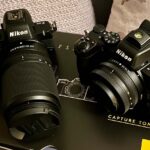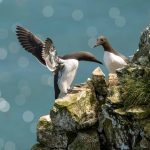If you’re a wildlife photographer looking for a new subject to photograph, you might be surprised to learn that you don’t have to venture too far from home to find it. In fact, you might find some fascinating subjects right in your own backyard! For me, that subject is photographing sparrows, a small and charming bird that frequents my garden in Preston, UK.

Our garden is a decent size and we’ve recently re-wilded it for the birds. As a result, we’ve attracted a good number of house sparrows who now nest in the eaves of our house. I’ve found that they feed in groups and mate for life, and even have an occasional visit from a sparrowhawk who likes to sit on the fence (a good sign of an healthy bird population).

To photograph these little birds, I started by clearing a space where they feed on the ground. Although they occasionally try our hanging feeders, they seem to prefer ground feeding. I found that getting low with my camera gave the best results, so I set up my popup hide and ground mat in a spot where I could observe them without spooking them.

My setup for photographing Sparrows.
My setup is quick and easy to sort. I use a Nitehawk popup hide and place a 6ft ground mat on the floor to lay down on. The mat has a reflective bottom so helps to keep me warm and dry. I have my Nikon Z50 and Sigma 150-600c resting on a bean bag that is filled with polystyrene balls. I originally had uncooked rice in there but it was too heavy to be carrying around.
My lens was set to 400mm and I was going to be just over 12ft away from the birds. It’s important to get low down but not too low. Too low means a lot more blades of grass to obscure the Sparrows.
Sparrows are small birds so having the lens wide open and F6 means there is enough depth of field to have detail in all of the birds and get that nice out-of-focus foreground and background.
I spent about three hours photographing them and tried to pick out Sparrows that had unknowingly moved away from the group for a few seconds.
They are very active birds so it was a bit of spray and pray, to get enough photographs to cherry-pick from. I think I had shoot around 250-300 photographs to get 9 keepers.

The house sparrows came in waves throughout the day, feeding communally and occasionally gathering nesting material. They can be quite noisy and call from the top of our hedges, but they’re also quite wary of what’s above them when they’re feeding on the ground. If spooked, they all leave together quickly.

To get the best photos, I set my camera’s aperture wide open to gain a shallow depth of field, which helped to blur the background and make the sparrows stand out. I also wanted a fast shutter speed of 1/1000s and over to freeze their fast movements, and I set my ISO sensitivity to auto to adjust for changing lighting conditions. Finally, I set my Auto Focus mode to continuous focus to keep up with their constant movement.

Overall, photographing sparrows in my garden has been a delightful and rewarding experience. With a little patience and some careful observation, I’ve been able to capture some stunning images of these small and fascinating birds. If you’re looking for a new subject to photograph, I highly recommend giving house sparrows a try!
Till next time,



